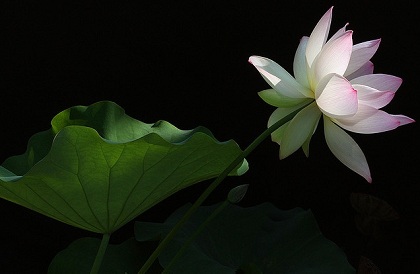Heart of Perfect Wisdom
Unknown
Rochester Zen Center
[From WikiPedia:] The Heart of Perfect Wisdom Sutra or Heart Sutra or Essence of Wisdom Sutra (Sanskrit: प्रज्ञापारमिताहृदय Prajñāpāramitā Hṛdaya; Chinese: 摩訶般若波羅蜜多心經) (the word sutra is not present in known Sanskrit manuscripts) is a well-known Mahāyāna Buddhist sutra that is very popular among Mahayana Buddhists both for its brevity and depth of meaning. Buddhist writer and translator Bill Porter calls the Heart Sutra the best known and most popular of all Buddhist scriptures.
The Heart Sutra is a member of the Perfection of Wisdom (Prajñāpāramitā) class of Mahāyāna Buddhist literature, and along with the Diamond Sutra, is perhaps the most prominent representative of the genre.
The Heart Sutra is made up of 14 shlokas in Sanskrit; a shloka composed of 32 syllables. In Chinese, it is 260 Chinese characters, while in English it is composed of sixteen sentences. This makes it one of the most highly abbreviated versions of the Perfection of Wisdom texts, which exist in various lengths up to 100,000 shlokas. According to Buddhist scholar and author Geshe Kelsang Gyatso in his commentary to the Heart Sutra:
The Essence of Wisdom Sutra (Heart Sutra) is much shorter than the other Perfection of Wisdom Sutras but it contains explicitly or implicitly the entire meaning of the longer Sutras.
This sutra is classified by Edward Conze as belonging to the third of four periods in the development of the Perfection of Wisdom canon, although because it contains a mantra (sometimes called a dharani), it does overlap with the final tantric phase of development according to this scheme, and is included in the tantra section of at least some editions of the Kangyur. Conze estimates the sutra's date of origin to be 350 CE; some others consider it to be two centuries older than that. Recent scholarship is unable to verify any date earlier than the 7th century CE.
The Chinese version is frequently chanted (in the local pronunciation) by the Chan (Zen/Seon/Thiền) sects during ceremonies in China, Japan, Korea, and Vietnam respectively. It is also significant to the Shingon Buddhist school in Japan, whose founder Kūkai wrote a commentary on it, and to the various Tibetan Buddhist schools, where it is studied extensively.
The sutra is in a small class of sutras not attributed to the Buddha. In some versions of the text, starting with that of Fayue dating to about 735, the Buddha confirms and praises the words of Avalokiteśvara, although this is not included in the preeminent Chinese version translated by Xuanzang. The Tibetan canon uses the longer version, although Tibetan translations without the framing text have been found at Dunhuang. The Chinese Buddhist canon includes both long and short versions, and both versions exist in Sanskrit.
Heart of Perfect Wisdom
___________________________________________________________________________________
The Bodhisattva of Compassion
from the depths of prajña wisdom
saw the emptiness of all five skandhas
and sundered the bonds that cause all suffering.
Know then:
Form here is only emptiness;
emptiness only form.
Form is no other than emptiness;
emptiness no other than form.
Feeling, thought, and choice—
consciousness itself—
are the same as this.
Dharmas here are empty;
all are the primal void.
None are born or die,
nor are they stained or pure,
nor do they wax or wane.
So in emptiness no form,
no feeling, thought, or choice,
nor is there consciousness.
No eye, ear, nose, tongue, body, mind,
no color, sound, smell, taste, touch,
or what the mind takes hold of,
nor even act of sensing.
No ignorance or end of it,
nor all that comes of ignorance:
No withering, no death, no end of them.
Nor is there pain, or cause of pain,
or cease in pain,
or noble path to lead from pain;
not even wisdom to attain:
Attainment too is emptiness.
So know that the Bodhisattva,
holding to nothing whatever,
but dwelling in prajña wisdom,
is freed of delusive hindrance,
rid of the fear bred by it,
and reaches clearest nirvana.
All buddhas of past and present,
buddhas of future time,
through faith in prajña wisdom,
come to full enlightenment.
Know then the great dharani,
the radiant, peerless mantra,
the supreme, unfailing mantra,
the Prajña Paramita,
whose words allay all pain.
This is highest wisdom,
true beyond all doubt;
know and proclaim its truth:
Gate, gate
paragate
parasamgate
bodhi, svaha![*]
___________________________________________________________________________________
[*] Edward Conze, who translated most of the vast Prajñāpāramita corpus, rendered this mantra into English as:
| "Gone gone, gone beyond, gone altogether beyond, O what an awakening, all hail!" |
Bodhi is an action noun from √budh "to wake up, to understand" and is generally taken to mean "awaken" in the Buddhist context. Svāhā is an expletive from Vedic ritual where it was used by ritualists as they made oblations to the fire. It is usually understood as deriving from su- + āha and therefore means "well said" (even Conze admits that his "all hail!" is not a good rendering). (Wikipedia)
___________________________________________________________________________________
Source. More about The Heart Sutra here. Photo: Bahman Farzad (flickr)

